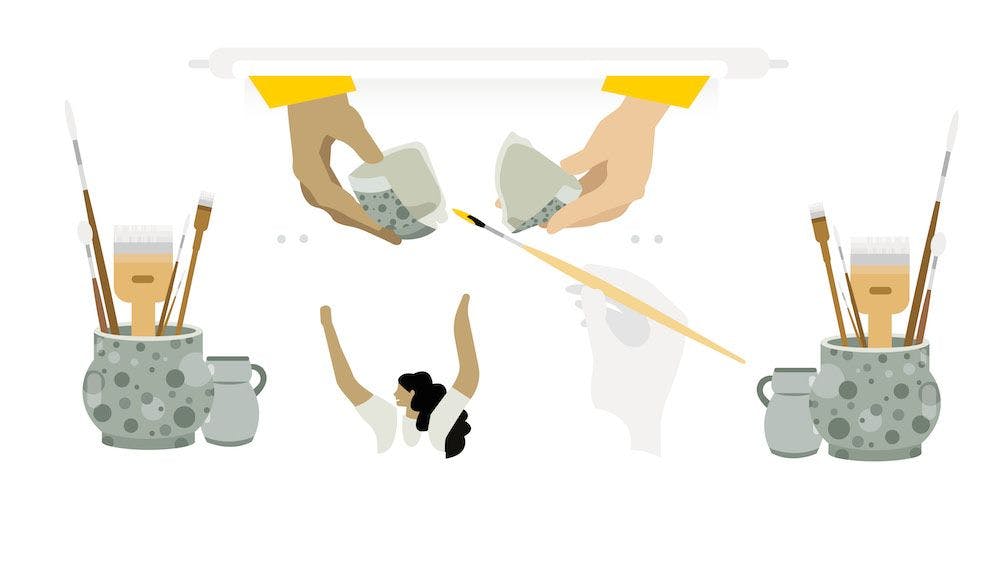
Could the Japanese art of pottery repair help us to embrace our imperfections, and celebrate them as things of beauty?
Few of us like to admit it, but we are less than perfect. No one can embody perfection at all times, no matter how hard they try. All too often we hide our mistakes, our struggles, our broken parts, doing our best to present only the best bits to the world at large. Yet it’s those unexpected turns, hard life lessons, and the journey we go on to become who we are that makes us – flaws and all.
Without our hardships, we wouldn’t be who we are today. Shouldn’t we, then, embrace these imperfections for what they are? Discovering more about the Japanese practice of repairing broken pottery could help us learn more about this mindset.
Origins

Using precious metals to give something broken or damaged new life is what the Japanese art of repairing broken ceramics focuses on, and is thought to date back to the 14th century. Instead of trying to hide the flaw or break, kintsugi turns that damage into a thing of beauty – something that can be celebrated and appreciated in its own right. Items that would once have been discarded can not only have a new lease of life, but are displayed with pride, and appreciated for their unique, one-of-a-kind beauty.
Linked by many with the Japanese philosophy of wabi-sabi (celebrating imperfection, impermanence, and incompleteness), kintsugi is seen by some as a physical manifestation of this ideology. While nothing lasts forever, with a little extra attention and care, even the most delicate and damaged things can be repaired, and made into something more beautiful and precious than before.
Turning flaws into things of beauty
If chipped, cracked, or flawed pottery can be appreciated for its history and uniqueness, why can’t we do the same with ourselves? If someone can take the time to repair beloved, delicate pottery, so too can we ‘repair’ ourselves – with enough time, self-care, reflection, and self-compassion.
Each of our experiences have in some way affected us, and helped to make us stronger. It’s time for us to acknowledge the chips and cracks in ourselves. By acknowledging the events that have impacted us, we can begin moving forwards – now a more beautiful, still whole person, with just a few more scars to show for the journey.
Embracing kintsugi in our daily lives
When things get tough and we feel overwhelmed, it can feel like we need to just ‘pull ourselves together’, and show only the best possible version of ourselves to the outside world. By hiding when we’re struggling, we can inadvertently let our problems and worries worsen. When we begin to share what is troubling us, we can seek help – and others may feel more ready and able to speak out and share their own experiences, too.
It’s time to embrace the trials you have faced, and recognise them as part of your journey
Could applying the ideas around kintsugi help us to better accept ourselves and our struggles, and start appreciating our own strengths? Here are three ways to try implementing kintsugi in your life:
Ditch the fear of being ‘damaged’. You are more emotionally resilient than you may think. By addressing the issues that have caused you pain or worry, over time you can become stronger, improve your emotional strength, and start learning how to best cope with adversity when it arises.
Embrace life’s scars. It’s tough to acknowledge, but we can’t hide our problems or sweep them under the rug. It’s time to embrace the trials you have faced, and recognise them as part of your journey. Our scars can make us stronger; they are proof that we have grown and overcome life’s challenges.
Reflection, not stagnation. Acknowledging the past without allowing it to take over or consume our thoughts is key. When we allow our present to be ruled by the past, we risk falling into self-pity, or becoming stuck in a negative cycle of past thoughts and events. Past challenges are still a part of you that should be recognised, but refocusing on how you have learned to overcome, embrace, work with or around them can help to avoid feeling stuck in the past.
In an age where social media reigns, and we only share our best side, going back to traditions, celebrating our journey, and our strength for what we have overcome, could be just what we need.

